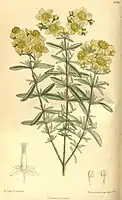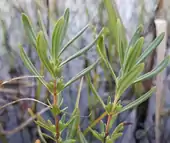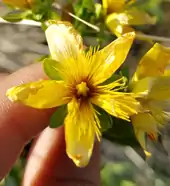| Hypericum kalmianum | |
|---|---|
 | |
| In cultivation | |
| Scientific classification | |
| Kingdom: | Plantae |
| Clade: | Tracheophytes |
| Clade: | Angiosperms |
| Clade: | Eudicots |
| Clade: | Rosids |
| Order: | Malpighiales |
| Family: | Hypericaceae |
| Genus: | Hypericum |
| Section: | H. sect. Myriandra |
| Subsection: | H. subsect. Centrosperma |
| Species: | H. kalmianum |
| Binomial name | |
| Hypericum kalmianum | |
| Synonyms[1] | |
|
Norysca kalmiana (L.) K. Koch | |
Hypericum kalmianum, commonly called Kalm's St. Johns wort[2] or Kalm's St. Johnswort,[3] is a flowering plant in the St. John's wort family Hypericaceae. It is native to the Great Lakes region in the northern United States and southern Canada. Hypericum kalmianum was named after its discoverer, Swedish botanist Pehr Kalm (1715-1779).[2]
Description
Hypericum kalmianum is a slender shrub that grows to a height of 20–60 cm (7.9–23.6 in). Its bark is whitish and papery. It has ascending four-edged branches that bear two-edged branchlets. The crowded bluish-green leaves are linear to oblanceolate and 3–4.5 cm (1.2–1.8 in) long. One to ten yellow flowers are borne on terminal and open corymbs, with each flower measuring 2–3.5 cm (0.8–1.4 in) wide. The leaf-like sepals are oblong and 5–15 mm (0.2–0.6 in) long. The ovoid capsules typically have five carpels and styles, though they can occasionally bear three, four, or six. The capsules are 7–10 mm (0.3–0.4 in) long and 4–7 mm (0.2–0.3 in) thick.[4]
The plant flowers between June and August.[5]
Taxonomy
Formerly included within Hypericum kalmianum is another species first formally described in 2016, Hypericum swinkianum.[6] Both species are part of the subsection Hypericum subsect. Centrosperma (H. sect. Myriandra). H. kalmianum can be differentiated from H. swinkianum by its narrower leaves, flowerheads averaging fewer than 7 flowers, and an affinity toward calcareous rather than acidic habitats.[2][6] Additional species of Midwestern Hypericum closely related to these two may be yet to be described.[6]
Distribution and habitat
Kalm's St. Johnswort is primarily found around the Great Lakes in Ontario, Quebec, Illinois, Indiana, Michigan, New York, Ohio, and Wisconsin.[1] In the Chicago Region, it is a highly conservative species that occur near Lake Michigan in calcareous sand prairies and marly pannés, and though rarely seen inland, can be found in prairie fens and mesic prairies.[2] It is classified as an endangered species in Illinois and threatened in Ohio.[3]
Gallery
 Botanical illustration, 1913
Botanical illustration, 1913 Leaves
Leaves Flower
Flower Fruits
Fruits
References
- 1 2 Robson, Norman (2015). "Hypericum kalmianum". In Flora of North America Editorial Committee (ed.). Flora of North America North of Mexico (FNA). Vol. 6. New York and Oxford: Oxford University Press. Retrieved 20 December 2018 – via eFloras.org, Missouri Botanical Garden, St. Louis, MO & Harvard University Herbaria, Cambridge, MA.
- 1 2 3 4 Wilhelm, Gerould; Rericha, Laura (2017). Flora of the Chicago Region: A Floristic and Ecological Synthesis.
- 1 2 "Hypericum kalmianum L." plants.usda.gov. Retrieved 2018-02-20.
- ↑ Merrit Lyndon Fernald (1970). R. C. Rollins (ed.). Gray's Manual of Botany (Eighth (Centennial) - Illustrated ed.). D. Van Nostrand Company. p. 1011. ISBN 0-442-22250-5.
- ↑ "Hypericum kalmianum (Kalm's St. Johns wort): Plant Phenology". iNaturalist.org. Retrieved 2018-08-19.
- 1 2 3 Wilhelm, Gerould; Rericha, Laura (2016). "A new species of Hypericum (Hypericaceae) and some new combinations in the vascular flora of the Chicago Region" (PDF). The Michigan Botanist. 55: 89–96.